| Key Takeaways |
|---|
| Creating a Lo-Fi Drum Beat: This involves selecting suitable kick, snare, and hi-hat samples, keeping in mind that the genre prefers softer, less aggressive sounds. The beats are usually not perfectly timed to emulate the imperfections of human play. |
| Chords and Melodies: Warm, vintage sounds from instruments like piano, guitar, or synth are preferred. The chord progression should be simple and repetitive, while melodies should complement the chord progression without being overly complex. |
| Bass: The bass should serve as a bridge between the rhythmic and harmonic sections of the song. A soft, humanistic bass part fits well with the Lo-Fi genre. |
| Sound Selection and Effects: Samples and loops should have a warm, vintage feel. The music should also feature subtle FX elements such as risers and impacts for a sense of ebb and flow. |
| Structure and Techniques: Lo-Fi beats are typically short, often between one and a half to two and a half minutes long. They require a balance between simplicity and variation, and experimenting with different sounds, effects, and field recordings can create a unique touch. |
Writing Lo-Fi Beats
Lo-Fi beats have become extremely popular in recent years. Countless study, relaxation, work, and sleep playlists are filled with Lo-Fi Hip-Hop.
It’s a very simple-sounding genre of music, created with just the right amount of variation to keep you engaged but not distracted.
However, don’t let the simplicity of the sound fool you into thinking it’s simple to produce. It takes time and experience to understand the fine line between creating a great Lo-Fi beat and a bad one.
In this article, we shall go through creating Lo-Fi music, guiding you through the musical elements, giving tips to elevate your beats, and helping you create music that fits into any Lo-Fi playlist.

Creating Lo-Fi Beats
You’re in luck if you want to create your own Lo-Fi beats. With the right software and tools, selecting suitable samples and loops, and a bit of creativity, you can easily create your own unique Lo-Fi beats.
Creating A Lo-Fi Drum Beat
The drum beat is the backbone of any Lo-Fi track. To create a Lo-Fi drum beat, select a kick, snare, and hi-hat sample.
For the kick drum, try to find a sound that is still the backbone of the beat but isn’t harsh or aggressive. Something softer will fit in much better, but still with enough attack to be heard.
The snare is free for all. You can use anything, from an actual snare to a twig snap. Experiment with different foley sounds and snare combinations to get the perfect soft snap for your beat.
For the hi-hats, I prefer to choose an acoustic drum sample. It has less high-end and a bit more body behind it. I will further filter out the high-end of this, but the character is perfect for this genre. High-hat and top loops are also great for adding more feel to your beat.
You can then program the beat using a MIDI controller or manually draw the notes.
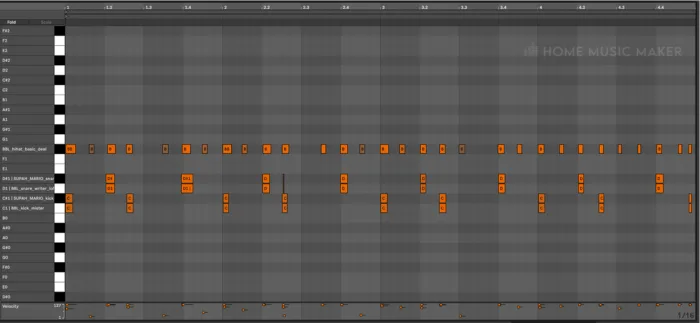
Whether you play them in on a MIDI controller or draw them in, Lo-Fi beats are known for having not perfectly timed drums. Having a snare or hi-hat hit come early or late embraces the imperfection of a human playing music.
There are definitely times and places for perfectly timed drums, but Lo-Fi is a genre that allows you to cut loose with all that.
When creating the beat, keep it simple and relaxed. Avoid using too many fills or complex rhythms. Instead, focus on creating a groove that’s easy to listen to and feels good.
Once the main beat is created, you can begin to layer this. Building the layers up over the song helps to evolve the music in a subtle but pleasing way. Adding an extra snare sound that changes the character of the snare without taking away what is there is a great choice.
Also, using different percussion loops in the background adds to the beat’s human feel and groove.
Chords
Once you have your drum beat, you can add chords.
Some good options include piano, guitar, and synth sounds. Incorporating Jazz chords will give your beat a more nostalgic and peaceful vibe, such as minor seven chords.
You don’t want sounds that are too bright for this. Warm and vintage sounds are all over Lo-Fi music. It wouldn’t make sense to have the vinyl crackle and Lo-Fi production mixed with a very sparkly clean guitar amp tone.
You can always try layering sounds for chords to get a truly unique tone. For example, a firm favorite pairing of mine is a piano virtual instrument with a soft, ambient pad. It adds an extra texture and dimension to the piano without losing that realistic and acoustic sound.
You can either record live instruments or use virtual instruments within your software. Personally, when I have the choice, I will choose live instruments. The subtle human error in playing is what gives Lo-Fi music life and feel.
But you can still achieve this by playing virtual instruments with a MIDI keyboard or controller.
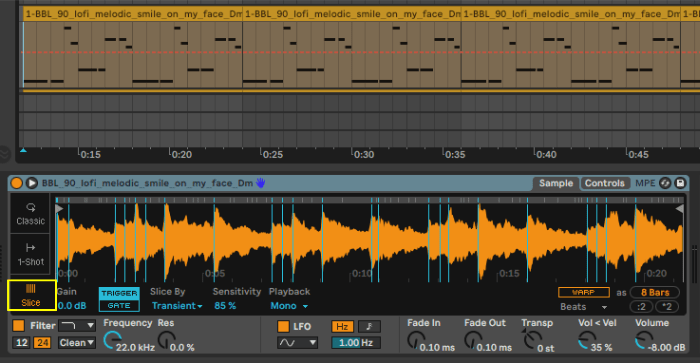
Another option is to base your chord progression on a sample chop. Unless I have a specific chord progression in mind, I will often chop a loop with a texture I enjoy. This also gives a real human feel as you manipulate sounds played by humans if you choose the right samples.
This then becomes the backbone of the harmonic structure. You will base your bass parts and melodic parts over this, hence why I mentioned chords after drums and not bass like other genres of Hip-Hop.
When adding chords, keep them simple and repetitive. Lo-Fi music creates a relaxing atmosphere. You don’t want to overwhelm the listener with too many chord changes.
You can still use the Jazz chords I mentioned, but keep the actual progression simple.
Bass
The next step in creating Lo-Fi beats is the bass. This is the glue between the rhythmic and harmonic sections of your song. Typically you will have some sort of bassline that compliments the rhythm of the drums and the melody and harmony of the rest of the parts.
The other option is a bass part that exactly follows the kick drum pattern.
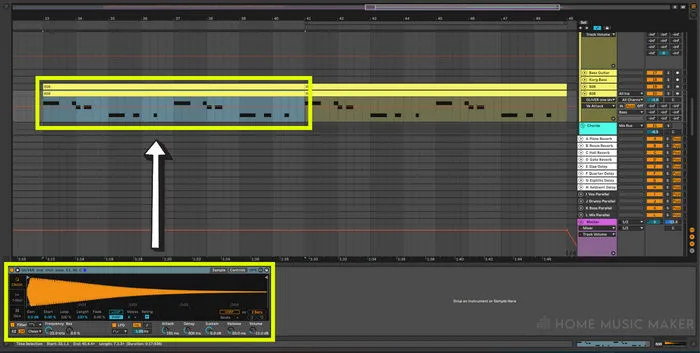
In terms of the sound you choose, it is really up to you, but you don’t want it to be an aggressive one. It’s meant to be a soft foundation for the rest of the pitched parts in the song.
Using a bass guitar with the tone rolled down is a great way to add a humanistic feel to the bass part while still having a soft solid bass part.
Another option is to use a soft, or even sub, 808 sample. This can complement the soft kick sound and create a bed where the other parts of the song can lay.
I like to use both a bass guitar and a soft 808. The bass guitar plays the same root notes, but I’ll sometimes throw in little bass fills between to add some variety to the part.
Melodies
The last musical part of creating Lo-Fi music is the melodies. There aren’t really hooks in Lo-Fi beats, but these are the closest aspect to them.
You have your lead melodies and then your background melodies. Let’s go through both.
Lead Melodies
The lead melody, or melodies, are at the forefront of the music. Just as most music uses vocals for this, we will create pleasant and interesting melodies using instruments.

You can still choose softer-sounding instruments or virtual instruments. For this, however, I like to choose something with a little bit more of a pluck to it. This helps it not get lost in the soft chords and to have its own place in the mix. Nothing crazy, of course, but that little something separates it from the rest of the music.
A few good choices for a lead instrument would be:
- Clean guitar on the bridge pickup
- Harpsichord
- Plucked violins
- Kalimba
As with the other music sections, you can layer these sounds too. Pairing a long bowed violin sound with a kalimba will create a sustaining and soaring melody, with just enough attack to cut through the mix.
You can also use sample chops here. Once again, utilize a sound that a human has played and recorded, shaping it to fit into your music and adding that extra lift to the song.
Once again, simplicity is key. You won’t want to be shredding a guitar solo over the relaxing beat. Creating a beautiful melody that compliments the chord progression and has variety is a fantastic place to start.
Note choice here is very important, as you won’t be playing lots of them, so you want to make each one count.
You can have the same melody throughout if it is varied enough in the first place, but you can also fade out of one melody and introduce a new lead. This creates more interest in the song.
With Lo-Fi, you’re constantly treading that fine line between too much and too little. Listen to your music in a similar setting to your audience, whether that’s relaxing or studying. See if it’s too repetitive or if it’s too complicated.
Background Melodies
To add to the richness of the sound, using background melodies that compliment the chords but don’t stick out works very well.
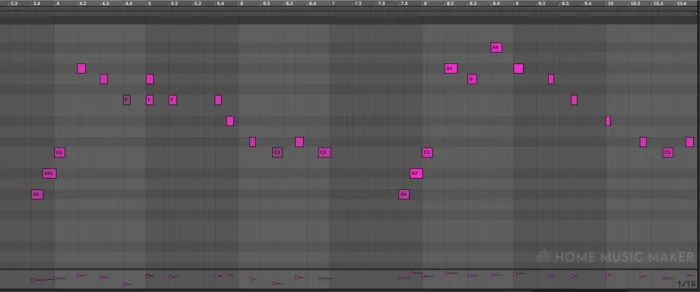
You don’t want to overpower the lead melodies. These are just little sounds in the background to evolve the song and add some nice ear candy. I’ll usually roll off more high-end from these melodies than the leads to not get in the way of the lead part.
A simple, arpeggiated, and soft synth sound works very well here. I typically drown these in reverb and set them back in the mix to where you can only hear them. Subtlety is key in Lo-Fi music, and these add to the sound in an impactful but discrete way.
FX
Finally, we have the FX.
These risers and impacts create an ebb and flow to the song. I know I’ve spoken a lot about subtlety, but here you need to be even more discrete with these sounds. You don’t want a massive build-up and release. You want a gentle push into the next section.

Using snaps and foley soaked in reverb, or white noise fading out, with a filter cutting some of the high- and low-end frequencies works a treat for the impacts. For risers, white noise fading in or an ocean wave make great risers. You can use a filter on the risers the same way you do for impacts.
Choosing The Right Software And Tools
Before creating Lo-Fi beats, you’ll need to choose the right software and tools. There are many different software options available, ranging from free to paid. Some of the most popular options include:
- Ableton Live
- FL Studio
- Logic Pro X
- Pro Tools
When choosing software, consider your budget, experience level, and the features you need. Additionally, you would have a much easier time with the right tools.
An excellent place to start is with a MIDI controller, headphones, and a good-quality audio interface.
READ NEXT:
If you are investing in music equipment, you should check out our guide on building a home studio on a budget.
You can write Lo-Fi music for free in a free DAW with the headphones you already have, but I suggest the equipment listed above, at the least.
But don’t let a lack of funds or equipment stop you from being creative.
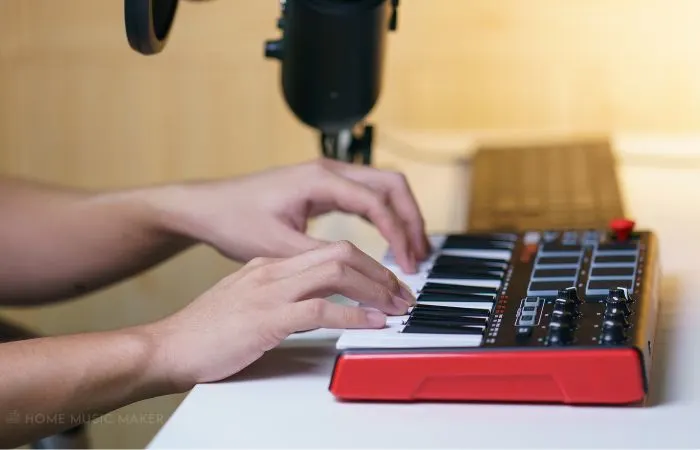
Selecting The Right Samples And Loops
One of the most critical aspects of creating Lo-Fi beats is selecting the right samples and loops.
You’ll want samples with a warm, vintage sound and slow, relaxed loops. Some good options include:
- Vinyl crackle samples
- Old Jazz and Soul samples
- Piano and guitar loops
- Drum breaks
- Loops played and recorded on real instruments
When selecting samples and loops, make sure they’re royalty-free and legal. You can find a variety of samples and loops online or create your own by recording live instruments or sounds.
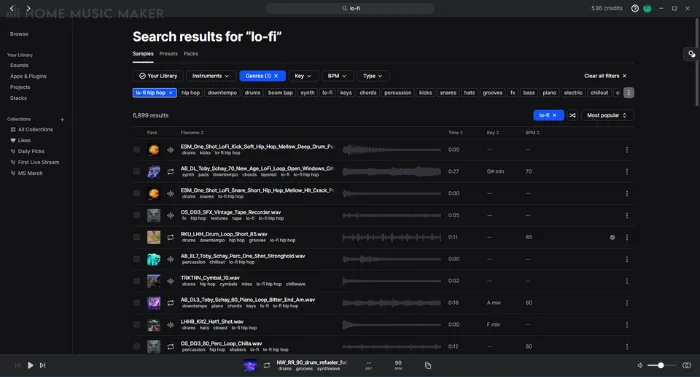
I recommend using Splice.
I’ve been making Lo-Fi beats for a few years, and Splice has been an absolute must, from providing whole song loops to chop up all the way to vinyl crackle. It’s amazing.
Structure
Lo-Fi beats are usually relatively short. A typical song is between one and a half minutes to two and a half minutes. Of course, there are exceptions, but for a song in this genre to be longer, it really has to step up and vary just the right amount.
A very common structure would be:
- An introduction usually consists of the chords and a melody stripped back without other elements and layering. It also usually has less high-end, through using a filter or EQ.
- The main beat, where the drums, bass, and some other elements are introduced, along with the full layered chords, the main melody, and no filter.
- A break, which consists of similar instrumentation to the introduction, but maybe with a new melody, percussive loop, and a chord progression change. It’s something slightly different to add variety.
- A variation of the main beat. This is the final section of the song and is usually the most dense in production. You can subtly change elements of the track, and introduce new ones, to evolve the song further.
Tips And Tricks
If you want to create incredible Lo-Fi beats, there are a few tips and tricks that you should keep in mind. Here are some of the most effective techniques:
Experimenting With Different Sounds
One of the best things about Lo-Fi music is it’s incredibly diverse. You can use a wide range of sounds to create your beats, including vinyl samples, field recordings, and even sounds from old video games.
You can use samples to incorporate more unconventional textures, or you can even go out and record things yourself. Helping you achieve a truly organic and unique sound.
Experiment with different sounds until you find the perfect combination that suits your style.
Using Effects And Processing Techniques
Effects and processing techniques are essential for creating the Lo-Fi sound. You can use distortion, EQ, compression, and other effects to add warmth, character, and texture to your beats.
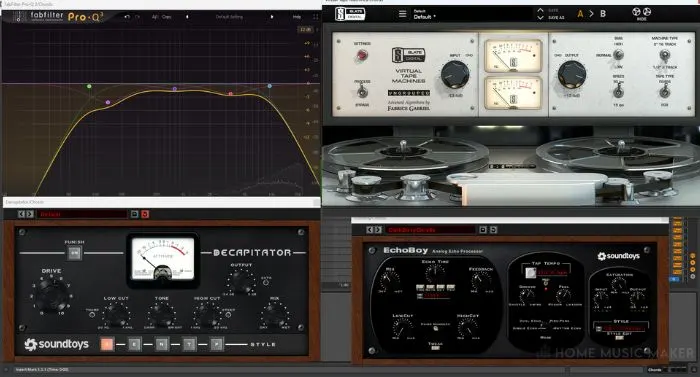
Experiment with different settings until you find the perfect sound. Additionally, you can use processing techniques like chopping, reversing, and time-stretching to create unique sounds and rhythms.
Some go-to effects that I always reach for when writing Lo-Fi music are:
Incorporating Field Recordings
Field recordings are an excellent way to add a unique touch to your Lo-Fi beats.
You can record sounds from your environment, such as birds chirping, cars passing by, or people talking, and use them as samples in your beats.
This technique can add a sense of nostalgia and atmosphere to your music, making it more engaging and immersive.
This allows you to create an environment for your music. I enjoy writing Lo-Fi music in coffee shops and will record the background noise while writing. This way, you hear where I was when I made that piece of music.
You can create incredible Lo-Fi beats that stand out from the crowd by experimenting with different sounds, using effects and processing techniques, and incorporating field recordings.
Keep practicing and refining your skills. You can create music that resonates with your audience and captures the essence of the Lo-Fi genre.
READ NEXT:
Another way to improve your Lo-Fi music and grow your fanbase simultaneously is through collaboration. To get involved, read our article on how music collaborations work.
Understanding Lo-Fi Beats
What Are Lo-Fi Beats?
Lo-Fi beats are a genre of music that originated in the 1990s. Their relaxed and chill vibe characterizes them. This is created using Lo-Fi (low-fidelity) production techniques.
Lo-Fi beats are often instrumental and incorporate samples from old Jazz, Soul, and R&B records, giving them a nostalgic and vintage feel.
History Of Lo-Fi Beats
Lo-Fi beats can be traced back to the 1990s when producers started experimenting with Lo-Fi production techniques. These techniques involved intentionally degrading the sound quality of recordings.
Lo-Fi beats became popular in the early 2000s with the rise of the internet, radio, and music streaming platforms.
Today, Lo-Fi beats are a staple in Hip-hop, Electronic, and Chill music. Countless playlists are dedicated to Lo-Fi beats for studying, sleeping, relaxing, and more.
Why Lo-Fi Beats Are Popular
Lo-Fi beats have gained popularity due to their relaxing and calming effect. They are often used as study music, background music for work, or to help with anxiety and stress.

Lo-Fi beats also have a strong sense of nostalgia, reminding listeners of simpler times and the music of their parents or grandparents.
The rise of social media platforms has also fueled the popularity of Lo-Fi beats. On YouTube and TikTok, Lo-Fi beats are often used as video background music.
Understanding the history and characteristics of Lo-Fi beats can help you create your unique sound within the genre. Incorporate vintage samples and lo-fi production techniques. Creating a relaxed vibe that resonates with listeners is essential.
Related Questions
What Are Some Common Chord Progressions Used In Lo-Fi Music?
In Lo-Fi music, simple and repetitive chord progressions are often used to create a relaxed atmosphere. Some common chord progressions used in Lo-Fi music include:
I-VI-IV-V: This is a very popular chord progression that can be heard in many Lo-Fi tracks. It’s a simple and effective way to create a nostalgic and emotional mood.
II-V-I: This is another standard progression in Lo-Fi music. It’s often used in Jazz and Blues music and can be adapted to fit a Lo-Fi aesthetic.
IV-V-VI-IV: This progression has been used in many popular songs and works well in Lo-Fi music. It’s a great way to create a sense of resolution and satisfaction.
How Can You Make Your Lo-Fi Music Sound Authentic And Vintage?
Consider using vintage equipment such as analog tape machines to get an authentic Lo-Fi sound.
Lo-Fi music often features distorted sounds, so don’t be afraid to experiment with distortion effects and plugins. Add some tape saturation, distortion, or overdrive to your instruments to give them a vintage feel.
Vinyl noise and hiss can add warmth and character to your Lo-Fi tracks. Lo-Fi music is all about imperfections. Don’t worry too much about perfect timing or pitch. Instead, embrace the raw and imperfect nature of your recordings.
How Do You Mix And Master A Lo-Fi Track To Get The Desired Sound?
EQ is a powerful tool that can be used to shape the tone of your instruments. In Lo-Fi music, cutting out some of the high and low frequencies is common to create a muffled and vintage sound.
Vinyl noise and hiss are an essential part of the Lo-Fi sound. Use a vinyl noise plugin or add some vinyl samples to your track to create a warm and vintage atmosphere.
Saturation and distortion can add warmth and character to your tracks. Experiment with different saturation and distortion plugins to find the right sound for your mix.
What Are Some Tips For Writing Lo-Fi Melodies?
Lo-Fi music is often characterized by its simplicity. Keep your melodies simple and repetitive. Use only a few notes and create a memorable melody that can be repeated throughout the track.
Minor keys can create a melancholic and emotional mood often associated with Lo-Fi music. Experiment with different minor keys to find the right vibe for your track.
Lo-Fi music is all about imperfections. Don’t worry too much about playing the perfect melody. Instead, embrace the raw and imperfect nature of your playing.
How Can You Experiment With The Lo-Fi Genre And Create Something Unique And Original?
Lo-Fi music can be combined with various genres, such as Hip-Hop, Jazz, and Electronic music. Try combining Lo-Fi with a different genre to create something new and unique.
Field recordings can add a unique and organic element to your tracks. Try incorporating sounds from the surrounding environment, such as city sounds, nature sounds, or ambient noise.
Lo-Fi music is all about the recording process. Try experimenting with different recording techniques. This can be through recording on an old tape machine, using vintage microphones, or recording in a natural environment.
READ NEXT:
Understanding the creation of Hip-Hop will help to further your Lo-Fi music. To learn this, check out our article on arranging Hip-Hop beats.

 Want to connect with other music producers for help and guidance?
Want to connect with other music producers for help and guidance?